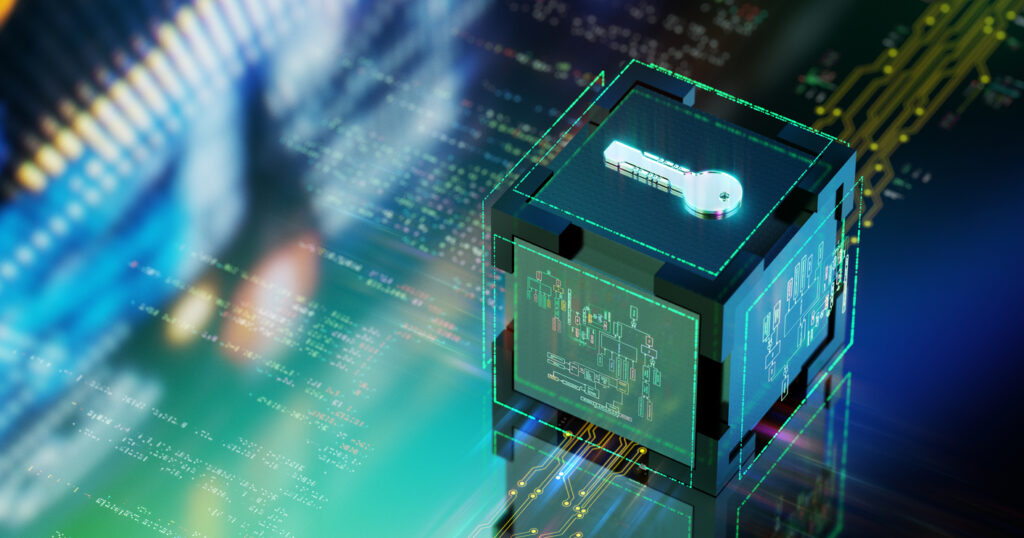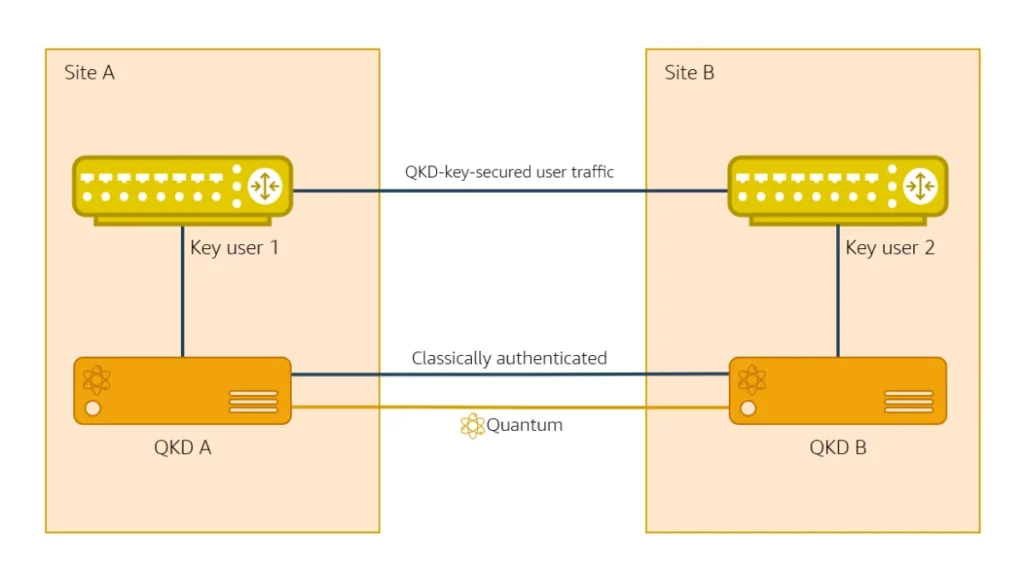
Quantum communication involves securely transmitting data and information using the principles of quantum physics. Traditional cryptographic methods rely on complex mathematical algorithms that quantum computers may easily break. In contrast, quantum communication provides a new way to secure data—leveraging quantum physics to enable far more robust encryption and interception-proof data transmission. A key quantum technology here is Quantum Key Distribution (QKD), which offers a higher level of security and allows for data exchange that, with current knowledge, cannot be intercepted undetected.
How does QKD work?
Quantum Key Distribution (QKD) is based on the principles of quantum superposition and the inherent disturbance caused by measurement. In QKD, cryptographic keys are distributed using quantum particles—often photons—whose states can exist in superposition. If someone attempts to intercept these photons by measuring them, the photon states change, thereby alerting the system that the data is at risk.
A typical example of a QKD system is the BB84 protocol, in which two parties exchange cryptographic keys encoded in photon states. Any eavesdropping attempt on the photons disturbs the key, which the original two parties can detect, prompting them to halt data transmission and ensure the key’s security.
Explanation of Quantum Key Distribution (QKD)
The underlying principle of QKD is that quantum states cannot be replicated or measured without altering their state. Participants who exchange keys via QKD can be certain that their communication remains clean and secure. If anyone attempts to eavesdrop, the quantum state is disturbed, and this change becomes immediately apparent to the parties involved. As a result, QKD is an exceptionally trustworthy method because data security does not depend on the complexity of solving mathematical problems but on the fundamental laws of quantum physics.
QKD is integrated with existing cryptographic methods to create hybrid systems offering multilayered security, resilient against a range of attacks—including those anticipated from future quantum computers.
Advantages and Disadvantages of QKD
QKD offers ultimate security because any attempt to eavesdrop on the data is immediately detectable. Quantum physics ensures that measurements change the states of the qubits. Consequently, as long as there are no disturbances, the communicating parties can be confident that the key remains uncompromised. Therefore, QKD is essentially unbreakable, guaranteeing data confidentiality even in a future where quantum computers become widespread.
Another advantage of QKD is its long-term resilience. While quantum computers may one day be able to break current cryptographic methods, QKD remains secure because it does not rely on the computational complexity of cryptographic algorithms.
However, QKD systems are technically complex and expensive, requiring specialized hardware such as quantum optical systems and photodetectors, which are both costly and challenging to maintain. The transmission range is also limited—covering long distances often requires quantum repeaters or optical fibers, which are expensive and complicated to implement with today’s technology.
QKD and Authentication: Facts vs. Myths

Quantum Key Distribution (QKD) is often discussed as a breakthrough in secure communications, but there are many misconceptions about its capabilities and limitations. One of the most debated aspects is authentication—an essential component of secure communication that QKD does not inherently provide. This article from Amazon Science takes a closer look at common misconceptions surrounding QKD, explaining its role in cryptographic security, its practical challenges, and the need for authentication in real-world implementations.
Read the full article here: Amazon Science – QKD and Authentication.
QKD Applications
QKD proves especially valuable in areas where data security is paramount. For instance, it can be applied in the defense and banking sectors, where the integrity and confidentiality of information are critical. By using QKD, financial transactions and the transfer of sensitive data can be secured against unauthorized access.
QKD also has potential for use in communication between governments and diplomatic institutions, where the security of classified and sensitive information is crucial. Through QKD, states can ensure that their communication remains protected and inaccessible to third parties.
Moreover, QKD can be implemented in the healthcare sector, where securely transmitting and storing patient data is essential. Finally, QKD contributes to the development of a “quantum internet,” paving the way for even more secure and faster data communication networks in the future.
Development of quantum communication in Estonia
Estonia is taking its first steps in the field of quantum communication by establishing a quantum communication test network. With a robust digital infrastructure and a wide array of e-government solutions, Estonia is developing quantum communication to ensure sustainable security. Government bodies, research institutions, and universities are actively investigating and advancing quantum communication technologies to enhance national security and foster innovation.
Future e-governance solutions incorporating quantum cryptography will enable an exceptionally high level of security for the government, citizens, and businesses—ensuring unprecedentedly secure data exchange and management.
The quantum communication test network in Estonia is being developed by the State Infocommunication Foundation (Riigi Infokommunikatsiooni Sihtasutus), the Ministry of Economic Affairs and Communications, and AS Metrosert, in cooperation with research institutions and private sector partners.